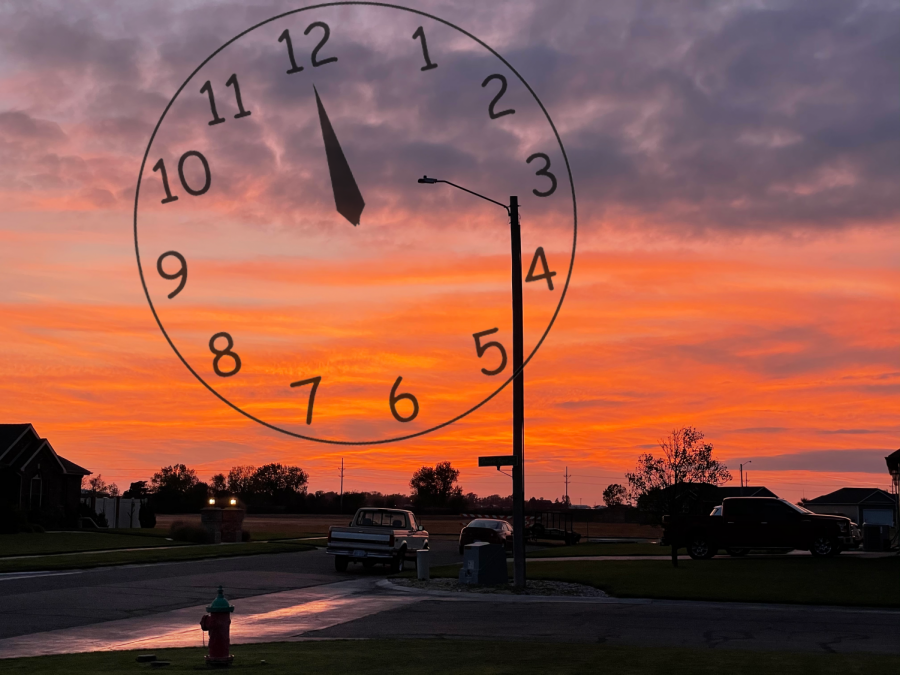Sign of the Time’s Change
October 25, 2021
It is almost time to reset the clocks and forget what time it is yet again as daylight saving time is coming to an end at 2:00 AM on Sunday, November 7. Because it is fall, we FALL back an hour, whereas in spring we SPRING forward an hour.
Daylight saving time can be a very controversial topic. Some states like Arizona and Hawaii don’t even follow DST. While it can be very inconvenient, what is the reason behind DST and is it actually necessary?
Zeth Turner said, “Yes, I think that we should comply with Daylight Saving Time so that we have an extra hour in the summer to do what we want to do.” In contrast, Jordan Manning said, “No, because it screws up our sleep pattern.”
According to my research, it is unclear the real reason behind the invention of DST. According to WebExhibits, the idea came from Ben Franklin and “the main purpose is to make better use of daylight. We change our clocks during the summer months to move an hour of daylight from the morning to the evening,” (Douma). On the other hand, Time said “The first Daylight Saving Time policy began in Germany on May 1, 1916, in the hopes that it would save energy during World War I,” (Waxman, 2017).
“I don’t know because there is pros and cons both ways,” said Alexis Stanley. I agree Alexis, there are pros and cons. Let’s break those down.
Pros:
- DST’s longer daylight hours promote safety.
- “Longer daylight hours make driving safer, lowers car accident rates, and lowers the risk of pedestrians being hit by a car,” (Top 3 pros and cons of daylight saving time).
- DST is good for the economy.
- “Later daylight means more people shopping after work, increasing retail sales, and more people driving, increasing gas and snacks sales for eight months of the year,” (Top 3 pros and cons of daylight saving time).
- DST promotes active lifestyles.
- “When the day is lighter later, people tend to participate in more outdoor activities after work,” (Top 3 pros and cons of daylight saving time).
Cons:
- DST is bad for your health.
- “Changing sleep patterns, even by one hour, goes against a person’s natural circadian rhythms and has negative consequences for health,” (Top 3 pros and cons of daylight saving time).
- DST drops productivity.
- “The Monday after the spring time change is called ‘Sleepy Monday,’ because it is one of the most sleep-deprived days of the year. The week after the spring DST time change sees an increase in “cyber-loafing” (employees wasting time on the internet) because they’re tired,” (Top 3 pros and cons of daylight saving time).
- DST is expensive.
- “The simple act of changing clocks costs Americans $1.7 billion in lost opportunity cost based on average hourly wages, meaning that the ten or so minutes spent moving clocks, watches, and devices forward and backward could be spent on something more productive,” (Top 3 pros and cons of daylight saving time).
As you can see, with both the multiple pros and cons and differing opinions, DST will most likely remain a highly debated topic because of all the positivity and negativity towards it.
References
Douma, M. (n.d.). Daylight Saving Time. WebExhibits. Retrieved October 24, 2021, from http://www.webexhibits.org/daylightsaving/c.html#:~:text=History%20%26%20info%20%2D%20Daylight%20Saving%20Time%20idea%20from%20Benjamin%20Franklin&text=The%20main%20purpose%20of%20Daylight,the%20morning%20to%20the%20evening.
Top 3 pros and cons of daylight saving time. ProCon.org. (2021, October 12). Retrieved October 25, 2021, from https://www.procon.org/headlines/top-3-pros-and-cons-of-daylight-saving-time/.
Waxman, O. B. (2017, November 1). Daylight saving origins: Who invented daylight saving time? Time. Retrieved October 25, 2021, from https://time.com/4549397/daylight-saving-time-history-politics/.



